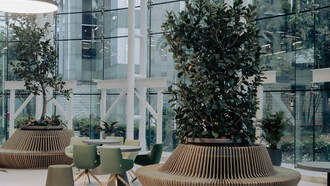In pursuit of our advancement, humans have weakened what has taken nature years of evolution to generate. Consequentially, a new-world threat is the viability of life on Earth.
It has become clear that with an ever-increasing global population, we are finding the importance of establishing new sustainable applications for renewable, energy-efficient, natural materials in the built environment. In the hopes that we will recover quality and alleviate the human impact of climate change.
This undertaking will foresee the collaboration of researchers in plant sciences, biochemistry, engineering, design, and architecture, creatively developing ground-breaking insights that monuvour and transform the way that we add to our built environment. Research that enables the replacement of conventional industrial materials with new, naturally-based materials requires less energy.
A sustainable alternative to those that they supplant.
The Silk Pavilion by OXMAN studies the relationship between digital and biological construction, offering a system that bonds the biologically spun and the robotically woven. The Silk Pavilion was motivated by the silkworm’s capability to spawn a three-dimensional cocoon out of a single silk thread. It was constructed with 6,500 live silkworms, aided by a robotic arm.
The collaboration of designers, artists, engineers, and scientists informed the understanding of how silkworm behaviour is learned by spatial and environmental conditions.
This alliance in the study of insect behaviour is informed by the crossover of many groups in differing fields, which proves that the study of one particular, in fact, is the study of multitudes. It poses the question of whether anything is only one thing.
Although the Silk Pavilion concept is within a contemporary context, it is important to note the important work of Charles Henry Turner, whose work as a zoologist began in 1907 and was dedicated to observing the behaviour of insects.
Turner was one of the first scientists to analytically explore complex cognition in animals considered least likely to possess it. His findings proved more complex cognitive abilities than scientists at the time believed were true; they could not fathom that individual insects within species behaved in accordance with their personalities.
In recent years, we have seen the production of opera shift anew, through a contemporary, collaborative collage of information. Rethinking for the empowerment of a future of complete synergy between humanity and the environment.
In his works 4’33 and Europeras, John Cage dismantles centuries of conventional expectation. Cage’s work continues to transform the effect of performance for musicians and audiences. It chisels deeper into the layers surrounding composition and its hierarchy.
Cage previously addressed the speculative narrative surrounding his works, which often ‘depart to a greater distance and question whether this music is music at all.’ His statement has become more rhetorical in a contemporary conceptual context. Whereby the boundaries of what was, in fact, may not be what is.
The heavy critique of Cage was his idea that classical music could vein out and continue to tell of its classicalness. Yet, his work informed this very notion: that with the classical also comes customary, a kind of uncomfortable silence that grows in spaces where we see and hear classic alongside, imbedded and held by an otherness.
It is only when we lean into openness that we may always find an eye for seeing and an ear for hearing.
John Cage created this openness by first permitting the allowance of awkwardness.
The development of natural materials, in conversation with the work of John Cage, creates an unexpected dialogue. The unlikely thread of collaboration and synergy between seemingly different pastures coming together to create a fuller whole, but first through, perceived awkwardness in learning a new means of operating together.
I think of the book The Object Stares Back by James Elkins: “Vision runs back and forth from objects to eyes, and whatever is seen also sees. And seeing is self-definition. Objects look back, and their incoming gaze tells me who I am. All this happens unnoticed, although it is the common thread of vision.”
Our society will constantly change in accordance with the quality and quantity of our environmental space. It is in each fragment of this space that information is held for better understanding. We are encouraging the unity of leaders in diverse fields to work collectively, in hope of a charge towards a harmonious means of living and existing in this space we call earth.















